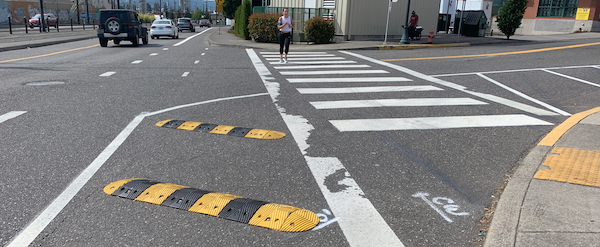Portland State Will Lead the Nation's DOTs to Active Transportation Solutions

- Shape the Active Transportation Roadmap: The project team will begin gathering input from transportation professionals in the coming months. Add your email address if you would like to be contacted.
Amid the explosion of active transportation literature over the last thirty years, practitioners struggle to effectively synthesize and use that research in their everyday practice. The interdisciplinary scope is vast: engineering, health and medicine, planning and design, psychology, public administration and policy, and many more. The search tools to find the sprawl of active transportation research on any one topic are inadequate, particularly for the average user. Meanwhile, there are still gaps in our knowledge about active transportation.
Seeking to address this unmet need, the National Cooperative Highway Research Program (NCHRP) has awarded Portland State University a $250,000 contract to develop an "Active Transportation Research Roadmap" on the nation’s research priorities for AASHTO's Council on Active Transportation.
Led by Jennifer Dill of PSU, the project team will work with partner Toole Design Group over the next two years to survey professionals across the U.S. and create a plan to implement the most relevant research findings around active modes of travel.
WHAT ARE THE PROJECT OBJECTIVES?
AASHTO’s Council on Active Transportation is a mix of state Department of Transportation representatives from across the country as well as AASHTO staff. The Active Transportation Roadmap and related products will be written and designed to aid the Council in implementing its strategic plan and state-by-state coordination of applied research. Some of the project goals are:
- Provide short executive summaries that are easily digestible by higher-level managers, as well as other readers with less time.
- Provide clear and convincing reasoning on the importance of the research and potential impacts of filling research gaps. For example, if we are able to answer question X, we can change how we redesign more safely a certain type of facility across the country where a specific number of pedestrians and bicyclists are killed or seriously injured each year.
- Make clear connections to specific existing AASHTO initiatives and programs, including those of the relevant councils and committees, not just the CAT.
- When relevant, explain the geographical context of the research findings and needs.
Below is a breakdown of the research plan to achieve these goals.
HELP US SHAPE THE RESEARCH ROADMAP
With input and approval from the panel, the team will use the consolidated list of research needs to create a survey to gauge practitioners’ views of the relative importance of the research needs. The survey will target the following audiences:
- AASHTO Research Advisory Committee members
- State DOT Pedestrian & Bicycle Coordinators
- Members of the TRB Bicycle and Pedestrian Committees
- Friends of the TRB Bicycle and Pedestrian Committees
- ITE Pedestrian and Bicycle Standing Committee
- Association of Pedestrian and Bicycle Professionals (APBP) members
- Additional groups suggested by the panel
The project team will begin gathering input from transportation professionals in the coming months. If you would like to be contacted, add your email address here.
THE PROJECT TEAM: NATIONAL LEADERSHIP
PSU is home to the Transportation Research and Education Center (TREC) as well as a U.S. DOT funded national university research center. Alongside Toole Design Group, the team has a broad knowledge of the current state of active transportation research and data-driven planning, and are active contributors to the national conversation around bicycle and pedestrian research.
Jennifer Dill, who will serve as the Principal Investigator on the roadmap project, has more than 25 years of experience linking research and practice in transportation planning. Members of the project team have directly contributed to:
- The Federal Transit Administration (FTA) Manual on Pedestrian and Bicycle Connections to Transit;
- The Federal Highway Administration (FHWA) Strategic Agenda for Pedestrian and Bicycle Transportation;
- The Manual on Uniform Traffic Control Devices (MUTCD);
- The National Association of City Transportation Officials (NACTO) Urban Bikeway Design Guide;
- The FHWA's Bikeway Selection Guide;
- and others.
Portland State University
Toole Design Group
The Transportation Research and Education Center (TREC) at Portland State University is home to the National Institute for Transportation and Communities (NITC), the Initiative for Bicycle and Pedestrian Innovation (IBPI), and other transportation programs. TREC produces research and tools for transportation decision makers, develops K-12 curriculum to expand the diversity and capacity of the workforce, and engages students and professionals through education.

